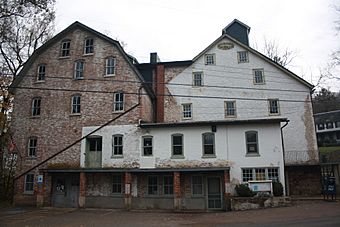Durham Mill and Furnace facts for kids
Durham Mill and Furnace is a very old and important place in Durham Township, Bucks County, Pennsylvania. It's a historic site that includes a grist mill (a mill that grinds grain into flour) and the remains of an old iron furnace. This spot played a big role in early American history, even helping out during the American Revolution.
What is Durham Mill and Furnace?
This historic site is made up of two main parts: an old iron furnace and a grist mill. The furnace was built first, way back in 1727. Later, in 1820, the grist mill was built on top of the furnace's original foundations. The entire area covers about 3.5 acres. It was added to the National Register of Historic Places in 1976. This means it's recognized as a special place worth protecting because of its history.
The Old Iron Furnace
The Durham Furnace started operating in 1727 and worked for 70 years. It was a busy place where workers made "pig iron" and "bar iron." These were important types of metal used for many things. During the American Revolution, the furnace helped the American army. It produced cannons, cannonballs, and other military equipment needed for the war.
One of the people who helped manage the furnace was Colonel George Taylor. He was a very important person because he signed the Declaration of Independence. This document announced that the American colonies were free from British rule.
The Grist Mill's Story
The grist mill building is a three-story structure made of stone. Inside, it has a large "overshot wheel." This type of water wheel uses the power of flowing water to turn the machinery that grinds grain.
In 1912, a large brick warehouse was added next to the mill. It has a special "gambrel roof," which looks like a barn roof. Around this time, a post office also opened at the mill. This post office, called the Durham Post Office, was actually founded much earlier, in 1723. It is one of the oldest post offices in the United States!
A well-known person named Reuben Knecht Bachman owned the mill in the late 1800s and early 1900s. He was a Congressman, meaning he was elected to represent his area in the United States government. The mill continued to operate and grind grain for businesses until 1967.
Gallery








